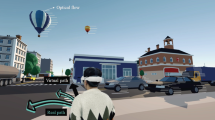Abstract
In daily life our behavior is guided by various visual stimuli, such as the information on direction signs. However, our environmentally-based perceptual capacity is often challenged under crowded conditions, even more so in critical circumstances like emergency evacuations. In those situations, we often fail to pay attention to important signs. In order to achieve more effective direction guidance, we considered the use of unconscious reflexes in human walking. In this study, we experimented with vision-guided walking direction control by inducing subjects to shift their gaze direction using a vection stimulus combined with body sway. We confirmed that a shift in a subject’s walking direction and body sway could be induced by a combination of vection and vibratory stimulus. We propose a possible mechanism for this effect.
Access this chapter
Tax calculation will be finalised at checkout
Purchases are for personal use only
Preview
Unable to display preview. Download preview PDF.
Similar content being viewed by others
References
Fridman, N., Kaminka, G.A.: Towards a Cognitive Model of Crowd Behavior Based on Social Comparison Theory. In: AAAI 2007, pp. 731–737 (2007)
Snowden, R.J., Thompson, P., Troscianko, T.: Basic vision: an introduction to visual perception. Oxford University Press (2006)
Leibowitz, H.W., Rodemer, C.S., Dichgans, J.: The independence of dynamic spatial orientation from luminance and refractive error. Perception Psychophysics 25(4), 75–79 (1979)
Post, R.B., Rodemer, C.S., Dichgans, J., Leibowitz, H.W.: Dynamicorientation responses are independent of refractive error. Investigative Ophthalmology and Visual Science 18, 140–141 (1979)
Fitzpatrick, R.C., Wardman, D.L., Taylor, J.L.: Effect of galvanic vestibular stimulation during human walking. The Journal of Physiology (517), 931–939 (1999)
Sugimoto, M., Watanabe, J., Ando, H., Maeda, T.: Inducement of walking direction using vestibular stimulation-The Study of Parasitic Humanoid (XVII). Virtual Reality Society of Japan 8, 339–342 (2003)
Hlavacka, F., Horak, F.B.: Somatosensory Influence on Postural Response to Galvanic Vestibular stimulation. Physiol. Res. 55(1), 121–127 (2006)
Yoshida, T., Takenaka, T., Ito, M., Ueda, K., Tobishima, T.: Guidance of Human Locomotion using Vection Induced Optical Flow Information. IPSJ SIG Technical Reports, vol. 2006(5)(CVIM-152), pp.125–128 (2006)
Suzuki, T., Ueno, A., Hoshino, H., Fukuoka, Y.: Effect of gaze and auditory stimulation on body sway direction during standing. IEEJ Transactions on Electronics, Information and Systems 127(10), 1800–1805 (2007)
Goodwin, G.M., Mccloskey, D.I., Matthews, P.B.C.: The contribution of muscle afferents to kinesthesia shown by vibration induced illusions of movement and by the effects of paralyzing joint afferents. Brain 95(4), 705–748 (1972)
Author information
Authors and Affiliations
Editor information
Editors and Affiliations
Rights and permissions
Copyright information
© 2013 Springer-Verlag Berlin Heidelberg
About this paper
Cite this paper
Watanabe, N., Omori, T. (2013). Unconscious Guidance of Pedestrians Using Vection and Body Sway. In: Chella, A., Pirrone, R., Sorbello, R., Jóhannsdóttir, K. (eds) Biologically Inspired Cognitive Architectures 2012. Advances in Intelligent Systems and Computing, vol 196. Springer, Berlin, Heidelberg. https://doi.org/10.1007/978-3-642-34274-5_59
Download citation
DOI: https://doi.org/10.1007/978-3-642-34274-5_59
Publisher Name: Springer, Berlin, Heidelberg
Print ISBN: 978-3-642-34273-8
Online ISBN: 978-3-642-34274-5
eBook Packages: EngineeringEngineering (R0)




